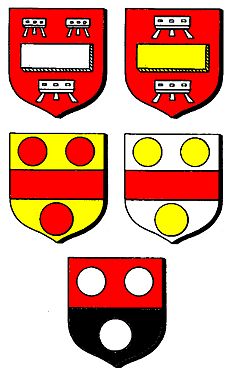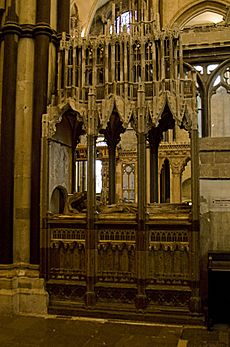John de Stratford facts for kids
Quick facts for kids |
|
|---|---|
| Archbishop of Canterbury Primate of All England |
|
 |
|
| Appointed | 3 November 1333 |
| Reign ended | 23 August 1348 |
| Predecessor | Simon Mepeham |
| Successor | John de Ufford |
| Other posts | Chancellor of England (1330–34, 1335–37, 1340) |
| Personal details | |
| Born | c. 1275 Stratford-on-Avon, Warwickshire, England |
| Died | 23 August 1348 Mayfield, Sussex, England |
| Buried | Canterbury Cathedral |
| Parents |
|
| Previous post |
|
John de Stratford (born around 1275 – died 1348) was a very important person in England during the 1300s. He held many powerful jobs, including Archbishop of Canterbury, which is the leader of the Church of England. He was also a Bishop of Winchester, the country's Treasurer, and the Chancellor of England. These roles made him one of the most influential people in the kingdom.
Early Life and Education
John de Stratford was born in Stratford-on-Avon around the year 1275. His family, the Stratford family, owned land in the area. His father was Robert de Stratford, and his mother was Isabel. John had relatives who were also important, including his nephew, Ralph Hatton, who later became a bishop.
We don't know much about John's early schooling. He studied at Oxford University, probably at Balliol College. By 1312, he had earned a special degree, becoming a doctor of civil law. This meant he was an expert in legal matters.
After his studies, John started working for the church. He slowly gained more important positions. By 1317, he was a rector (a type of priest) in Stratford. He also worked for the Bishop of Lincoln. Later, he moved to Canterbury to work for Archbishop Walter Reynolds. He held several church roles, including canon (a church official) in different cathedrals.
A Powerful Career
John de Stratford's career quickly became very important. Before 1323, he was already an archdeacon and a dean in the church. On 20 June 1323, he was made Bishop of Winchester. This appointment happened while he was visiting Pope John XXII in France. King Edward II was not happy about this appointment.
In 1327, Bishop Stratford joined a group supporting Queen Isabella. She was the wife of King Edward II. He helped write a list of reasons against the king. He was also part of the group that visited the king in prison. They asked him to give up his throne to his son. On 26 November 1326, John became the Lord High Treasurer of England. He held this important financial role for a few months.
Under the new king, Edward III, John de Stratford became a key member of the royal council. This council advised the king. Stratford was seen as a main supporter of Earl Henry of Lancaster. Together, they helped organize a petition in London in 1328. This petition complained about the government run by Roger Mortimer and Queen Isabella.
John's political power grew a lot in 1330. This was when Roger Mortimer lost his influence. King Edward III chose Stratford to be his new Lord Chancellor on 28 November 1330. For the next ten years, John was very active in running the country. He was the king's most important advisor. He was also seen as the leader of the group that supported the idea of a strong parliament.
In 1329 and 1332, he was involved in the case of Christina Carpenter. She was a religious recluse who had left her cell. She later asked to return to live out her life there.
On 3 November 1333, Stratford was appointed Archbishop of Canterbury. This was a very high position in the church. He then left his role as chancellor in 1334. However, he became chancellor again for two years, from 1335 to 1337. His younger brother, Robert de Stratford, often filled in for him. John was appointed chancellor a third time in 1340. He served for about two months before resigning due to poor health. His brother Robert took over again.
In November 1340, King Edward III returned to England from Flanders. He was angry and had little money. He blamed the archbishop's brother, Robert, who was the chancellor. The king even briefly imprisoned another relative, Henry de Stratford. Fearing arrest, the archbishop went to Canterbury. He had a strong disagreement with the king. His firm actions helped establish an important rule. This rule stated that important noblemen could only be tried in parliament by their peers. Soon, the king and the archbishop made up. John acted as the head of the king's council when Edward was away in 1345 and 1346. However, he never regained his earlier level of influence.
Later Life and Legacy
Even though his main political career was mostly over, John de Stratford remained an important advisor. From 1342 until his death, he was seen as a wise elder statesman. In June 1348, he became ill. He passed away on 23 August at his home in Mayfield, Sussex. He was buried in Canterbury Cathedral on 9 September. His tomb, with a stone statue of him, is still there today.
John de Stratford made many contributions. He created detailed rules for the church courts in 1342. He also wrote several sets of church laws between 1341 and 1343. These laws focused on how the church should be run. They also aimed to protect the church's freedoms.
He was a generous supporter of a hospital in Canterbury. But his main efforts were focused on his hometown of Stratford. There, he founded a special college for priests in 1331. He wanted to make sure the local church was well-supported.
People have different ideas about John de Stratford's personality and goals. Some compare him to earlier archbishops. However, his calm approach and legal skills helped make the change of kings in 1326–27 go smoothly. He strongly believed in the importance of parliament. He even risked his career to support these ideas. He was also a strong defender of the English church's freedoms.
He was ambitious, but he also had strong beliefs. By 1337, he knew that war with France was unavoidable. But he didn't want it to lead to unfair treatment at home. He didn't want to cause another civil war. The king once accused him of pride. But John's smart defense in 1340–41 taught King Edward a valuable lesson.



